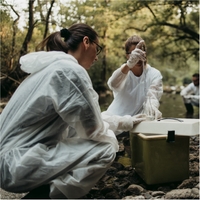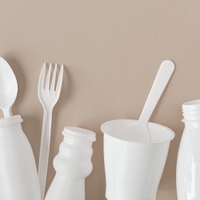
Plastic infant feeding bottles release high levels of microplastics
New research shows that high levels of microplastics are released from polypropylene (PP) infant feeding bottles during routine bottle sterilisation and formula preparation processes (1).
The study, published in the journal Nature Food, found that average infant exposure levels from PP infant-feeding bottles exceed 1 million microplastic particles per day (1).
Previous research has shown that adults and children in the United States are consuming between 74,000 and 113,000 microplastic particles per year via food and water consumption, and air inhalation (2,3). However, this new study shows that the exposure levels could be much higher.
In the current study, researchers analysed the potential for release of microplastics from PP infant-feeding bottles during formula preparation by following World Health Organisation (WHO) guidelines for cleaning, sterilising, and mixing (4). Researchers analysed 10 representative infant-feeding bottles that account for 68.8% of the global infant-feeding bottle market (1).
Under a standardised protocol, after sterilisation and exposure to water at 70°C (the recommended temperature for infant formula preparation (4)), the PP bottles released high quantities of microplastics, ranging from 1.31 - 16.2 million particles per litre. These results far exceed the WHO low risk limits of 0.01 – 10,000 particles per litre of drinking water (5).
During infant formula preparation, infant-feeding bottles can be exposed to temperatures up to 100°C, under WHO guidelines (4). Given that plastics are thermally sensitive materials, researchers repeated the testing protocol and exposed bottles to deionised water with temperatures of 25, 40, 70 and 95°C.
Even at 25°C, which is significantly under international guidelines for sterilisation or formula preparation (4), 0.6 million microplastic particles per litre were generated. When the temperature was increased to 95°C, the release of microplastics increased to 55 million particles per litre (1).
The researchers also estimated the exposure of 12-month-old infants to microplastics in 48 countries and regions. These calculations used microplastic release rates from the PP infant-feeding bottles, the market share of each PP infant-feeding bottle, the infant daily milk-intake volume, and breastfeeding rates.
Overall average daily consumption of PP microplastics by infants per capita was 1.58 million particles, with average daily intakes ranging from 0.0146 – 4.55 million particles, depending on the region (1). The average daily consumption level corresponds to about 2,600 times the total adult consumption of microplastics from water, food and air (2,3).
Oceania, North America, and Europe have the highest levels of potential exposure, at 2.1, 2.28, and 2.61 million particles/day, respectively. Estimated daily exposure levels of Australian infants is 1.86 million particles, which exceeds the global average (1).
The researchers caution that measurements are likely to be an underestimation due to the filter size used in the study which do not capture nanoparticles (diameter ~100 nm). Additionally, these nanoparticles aggregate in water, making quantification challenging. Regardless, in the order of trillions of nanoparticles per litre were reported (1).
Microplastics are ubiquitous in the environment; however, their human health risks are not yet fully understood. Long-term microplastic exposure may cause particle toxicity, oxidative stress, inflammatory lesions, immune dysfunction, and increase the risk of cancer (6). Further research is urgently required to assess the risk of microplastics to human health, requiring knowledge on human exposure, pathogenesis, and toxicity effects.
Given the global preference for PP infant-feeding bottles and the unknown health risks associated with microplastics, it is important to mitigate against unintended generation of microplastics in infant formula. Recommendations from the current study to reduce infant exposure to microplastics include (1):
- Rinsing sterilised feeding bottles with cool sterile water (boiled water using non-PP kettles and cooled down to room temperature) to remove microplastics on walls of sterilised bottles.
- Preparing infant formula in a non-plastic container using at least 70°C water and transferring into a high-quality plastic infant feeding bottle when cooled to room temperature.
- Avoiding the re-heating of formula in plastic bottles in microwaves.





